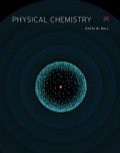
(a)
Interpretation:
Whether the given species have permanent dipole moment or not is to be predicted.
Concept introduction:
Dipole moment is defined as the product of the distance and the amount of charge. Dipole moment arises due to the difference in the electronegativity of the atom or ions in a molecule. The dipole moment is from lower electronegative atom to higher electronegative atom.
(b)
Interpretation:
Whether the given species have permanent dipole moment or not is to be predicted.
Concept introduction:
Dipole moment is defined as the product of the distance and the amount of charge. Dipole moment arises due to the difference in the electronegativity of the atom or ions in a molecule. The dipole moment is from lower electronegative atom to higher electronegative atom.
(c)
Interpretation:
Whether the given species have permanent dipole moment or not is to be predicted.
Concept introduction:
Dipole moment is defined as the product of the distance and the amount of charge. Dipole moment arises due to the difference in the electronegativity of the atom or ions in a molecule. The dipole moment is from lower electronegative atom to higher electronegative atom.
(d)
Interpretation:
Whether the given species have permanent dipole moment or not is to be predicted.
Concept introduction:
Dipole moment is defined as the product of the distance and the amount of charge. Dipole moment arises due to the difference in the electronegativity of the atom or ions in a molecule. The dipole moment is from lower electronegative atom to higher electronegative atom.
(e)
Interpretation:
Whether the given species have permanent dipole moment or not is to be predicted.
Concept introduction:
Dipole moment is defined as the product of the distance and the amount of charge. Dipole moment arises due to the difference in the electronegativity of the atom or ions in a molecule. The dipole moment is from lower electronegative atom to higher electronegative atom.
(e)
Interpretation:
Whether the given species have permanent dipole moment or not is to be predicted.
Concept introduction:
Dipole moment is defined as the product of the distance and the amount of charge. Dipole moment arises due to the difference in the electronegativity of the atom or ions in a molecule. The dipole moment is from lower electronegative atom to higher electronegative atom.
Want to see the full answer?
Check out a sample textbook solution
Chapter 13 Solutions
EBK PHYSICAL CHEMISTRY
- 8. What is the major product of the following reaction? KMnO4 b a TOH OH OH C d OH "OH HO OH OHarrow_forwardChoose the right answerarrow_forward3. Draw ALL THE POSSBILE PRODUCTS AND THE MECHANISMS WITH ALL RESONANCE STRUCTURES. Explain using the resonance structures why the major product(s) are formed over the minor product(s). H₂SO4, HONO CHarrow_forward
- 7. Provide the product(s), starting material(s) and/or condition(s) required for the No mechanisms required. below reaction HO + H-I CI FO Br2, FeBr3 O I-Oarrow_forward6. Design the most efficient synthesis of the following product starting from phenot Provide the reaction conditions for each step (more than one step is required) and explain the selectivity of each reaction. NO MECHANISMS ARE REQUIRED. OH step(s) CIarrow_forwardWhat is the skeletal structure of the product of the following organic reaction?arrow_forward
- If a reaction occurs, what would be the major products? Please include a detailed explanation as well as a drawing showing how the reaction occurs and what the final product is.arrow_forwardWhat is the major organic product of the following nucleophilic acyl substitution reaction of an acid chloride below?arrow_forwardWould the following organic synthesis occur in one step? Add any missing products, required catalysts, inorganic reagents, and other important conditions. Please include a detailed explanation and drawings showing how the reaction may occur in one step.arrow_forward
- If a reaction occurs, what would be the major products? Please include a detailed explanation as well as a drawing showing how the reaction occurs and what the final product is.arrow_forwardPlease help me answer the following questions using the data I included. 1&2arrow_forwardAssign all the Protons in HNMRarrow_forward
 Chemistry: The Molecular ScienceChemistryISBN:9781285199047Author:John W. Moore, Conrad L. StanitskiPublisher:Cengage Learning
Chemistry: The Molecular ScienceChemistryISBN:9781285199047Author:John W. Moore, Conrad L. StanitskiPublisher:Cengage Learning Chemistry & Chemical ReactivityChemistryISBN:9781337399074Author:John C. Kotz, Paul M. Treichel, John Townsend, David TreichelPublisher:Cengage Learning
Chemistry & Chemical ReactivityChemistryISBN:9781337399074Author:John C. Kotz, Paul M. Treichel, John Townsend, David TreichelPublisher:Cengage Learning General Chemistry - Standalone book (MindTap Cour...ChemistryISBN:9781305580343Author:Steven D. Gammon, Ebbing, Darrell Ebbing, Steven D., Darrell; Gammon, Darrell Ebbing; Steven D. Gammon, Darrell D.; Gammon, Ebbing; Steven D. Gammon; DarrellPublisher:Cengage Learning
General Chemistry - Standalone book (MindTap Cour...ChemistryISBN:9781305580343Author:Steven D. Gammon, Ebbing, Darrell Ebbing, Steven D., Darrell; Gammon, Darrell Ebbing; Steven D. Gammon, Darrell D.; Gammon, Ebbing; Steven D. Gammon; DarrellPublisher:Cengage Learning


